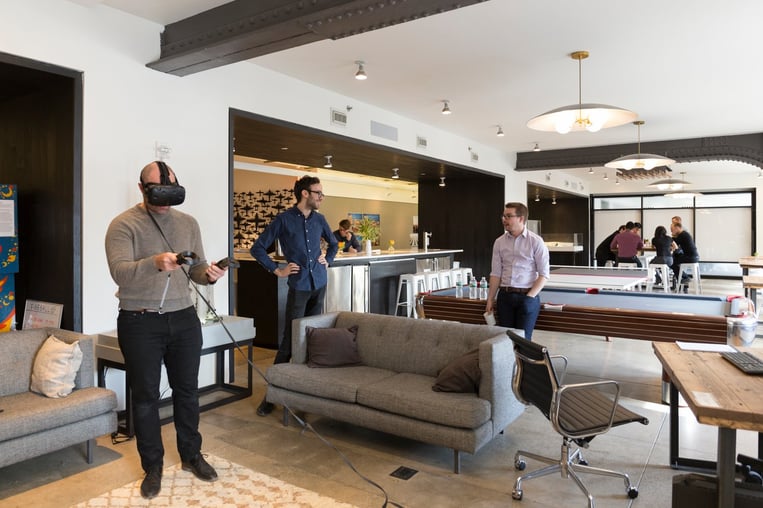Back in January, we gathered quotes from 16 thought leaders in the AEC space about what they predicted for the growth and expansion of technology in 2019.
We received responses touching on everything from IoT (the Internet of Things), to AR (augmented reality) on the job site, to the rise of digital twins—all of which sparked a lot of great conversations about the continual development technology for engineering, construction, and architecture.
But now that it’s September, most of the year has gone by. We recently reached out to the thought leaders who contributed to our original blog post to find out whether or not their predictions have become a reality.
Read on to find out what’s come true, what hasn’t, and how the AEC tech landscape is looking as we move toward 2020.
Evan Troxel, Director of Digital Projects | Associate Principal | Architect at HMC Architects

In his original prediction, Evan wrote about the challenges large architecture firms face involving the flow of data and information. He predicted that, as coding and scripting become more widely adopted skills within AEC, data will start being passed more frequently and more fluently across teams, empowering stronger collaboration.
Update:
“Based on a couple of key technologies (built for linking early design models to BIM) fortuitously released this year, some of my original predictions are coming true. These tools allow us to eliminate the wasteful process of rebuilding our models because we now have true interoperability in our pipeline—with the added benefit of not having to be limited to tools that are not well-suited for the project. (If you'd like to know what they are specifically, they are the Rhino.inside project by McNeel and Associates, and Speckle.Works by speckle.systems).
In addition, we have been internally building a data warehouse to further connect and glean information that's been traditionally siloed in different databases. We've invested in programming and development of our data warehouse platform, allowing us to connect disparate sources together so we will have much more insight, which is really exciting.”
Evan wrote a blog post on using data analytics in architecture to embrace communities in design for HMC. He also hosts the Archispeak podcast.
Geof Bell, Associate VDC at SHoP Architects

Back in January, Geof wrote about how SHoP Architects is already using VR to create and explore digital environments—and predicted that, in 2019, AR would take on a more important role in that equation. He also predicted that ultimately (“perhaps not that far in the future”) conventional drawings could be eliminated entirely from the design and construction process through technologies like AR and real-time 3D scanning and digitization.
Update:
“Historically, the role of technology in design has been about abstraction of the act of design, through computation, screens, keyboard, and mouse. What we've continued to find in our work at SHoP is that the current generation of technology enables a much more humanistic level of interaction with design technology. Augmented reality lets designers spatialize their work in real environments, and new solutions being introduced now let devices "read" urban contexts to anchor projects with a greater level of accuracy.
New software is being developed to connect HoloLens headsets and mobile devices to Grasshopper, allowing computational design to take place in a gesture-based design environment. Machine learning applications are starting to allow designers to operate much more fluidly, recognizing design intent and filling in data that would otherwise take hours of effort. Robotics are allowing us to take designs immediately from these humanistic design environments and automate the production of physical prototypes, shrinking the gap between thinking, design, and making (plug: some of SHoP's team members are leading a workshop exploring the intersection of VR, AR and robotics at this year's ACADIA conference). Computational design produces enormous amounts of data, and the ability to understand that data on a human level using mixed reality is a huge boon in a visually-oriented profession.
SHoP has a long history of utilizing both computational design and advanced fabrication processes, and we're using all these new tools to make that process even better for our designers, clients, and partners—all in the service of trying to create better environments for people. Being able to interact with designs and data on a human level makes this work more approachable, and allows us to focus on making great spaces.”
Read our case study with SHoP Architects to learn how they have implemented VR tools into everyday workflows.
Paul Wilkinson, Editor, ExtranetEvolution.com

Paul predicted that digital twins would continue to rise in popularity throughout 2019. He focused on the idea that these digital replicas of real built assets would eventually be created by these built assets, as well as on the concept of these digital twins becoming more interconnected across nations.
Update:
“As predicted, we do seem to be hearing more about digital twins in 2019. The ‘Gemini Principles’ guidance produced by the Centre for Digital Built Britain (CDBB)'s Digital Framework Task Group in late 2018 has been followed up by a 'roadmap' (published in April 2019) setting out how the framework will be delivered, and how it will enable the development of the national digital twin: ‘an ecosystem of digital twins, connected via securely shared data.’
In parallel, the CDBB has launched a ‘Digital Twin Hub,’ a community for owner-operators where they can share their early thinking and initial developments. This includes nuclear power station operators and water companies, and will, in due course, open its doors to share insights with designers and constructors so that the industry currently known as construction can learn from real data generated by built assets in service. And the CDBB hosted a ‘National Digital Twin Day’ at the Institution of Civil Engineers in London on 9 September (disclosure: I chaired a session at the conference).
This adds to a steady stream of events focused on digital twins, with technology vendor Bentley Systems hosting breakfast meetings about the concept and its 2019 Year in Infrastructure conference in Singapore in October subtitled ‘Advancing BIM through Digital Twins.’ This subtitle suggests industry digital transformation is now moving beyond its recent preoccupation with building information modeling. Businesses are recognizing that BIM is not the end game—it's a stage on the journey towards delivering a better, more connected built environment.”
Arjen van Berkum, COO, Another Monday
 Arjen’s predictions for 2019 ran the gamut from the emergence of new building materials to new forms of building management utilizing digital twins. He also wrote on the combination of digital robots (machine learning programs) and physical robots in construction and manufacturing, as well as the increasing demand for a “circular economy” based around energy-efficient processes.
Arjen’s predictions for 2019 ran the gamut from the emergence of new building materials to new forms of building management utilizing digital twins. He also wrote on the combination of digital robots (machine learning programs) and physical robots in construction and manufacturing, as well as the increasing demand for a “circular economy” based around energy-efficient processes.
Update:
“For any technology guru, wizard, influencer...it is always good to reflect after some months on any prediction, to see if the crystal ball delivered, so to speak.
Let me start by saying that I have been surprised by the speed of development of the circular economy. [I’m noticing] cool initiatives in using recycled plastics as building blocks picking up speed, and I see thinking about unrestricted use of materials becoming a thing of the past. Now we need to boost the production of alternate materials faster and faster. This is a change and an opportunity. Prediction coming true!
The merging of the physical and the digital robot is picking up speed, but to be honest, it is going slower than I would have liked and thought. This is especially true in the world of old legacy applications and merging them into the world of AI and IOT using robotics as a bridge technology. Prediction not fully being realized.
The call for urban farming and other initiatives to cool cities in the changing climate is—thanks to another hot summer in Europe—is picking up. Thinking on how to use “green” initiatives in urban design, replanting of trees in cities, and even discussions to build more parks or use rooftops better is not something that is a fairytale. It could go much faster, but the speed is picking up. Prediction coming true.
I also wrote about the role of the human being becoming more and more important again and bringing stuff to scale, especially in those areas where the machine is not (yet?) able to follow. I had hoped to see big steps in learning by using AR and VR but broadly speaking it is rather slow on the pick up (though there are many firms actively using the technology). The convergence of technologies is, however, happening. Slowly but certainly we see the number of connected devices going through the roof, and robotics are becoming more and more mainstream. So, in short, the crystal ball bordered on revolution whilst reality is, as it usually is, evolution.”
AkitaBox

In his original response, AkitaBox CTO and co-founder Robbie Steinbock wrote about the digitization of maintenance records for building managers. For our update, AkitaBox Director of Engineering Scott Tilemma reports on the state of this prediction.
Update (Scott Tillema, Director of Engineering at AkitaBox):

"It's incredibly exciting to know how far facilities technology has come along and what's to come for the industry. Current software capabilities allow us to do so many things to automate the buildings we live, work, and play in. But what we are most excited for at AkitaBox is what the future holds surrounding the data that can be collected within these buildings and how quickly it can be collected.
Our eventual goal is to be able to collect data from buildings—for example, space, mechanical asset, and room data—at the speed of walking through them. This can be conducted through a variety of technologies such as LiDAR, AR or even within our own facility management software, and then quickly turned over to building owners. The possibilities are endless."
Dan Stine, Author, Blogger, BIM Educator

In his initial response, Dan anticipated an explosion in immersive design communication using VR and AR. In addition, he touched on generative design, deep learning, reality capture, IoT sensors, and POE (post occupancy evaluations).
Update:
"Keiran Timberlake’s ROAST tool, for post occupancy evaluations, is fully live. LHB is using multiple Microsoft HoloLens devices used in the same space to facilitate multiuser augmented reality (AR); plus, the Microsoft HoloLens 2 is coming soon from what I hear! Our Integrative Design Team (IDT) studio is now doing virtual project pinups every other week using NVIDIA RTX-enabled hardware and software, allowing staff to see what others are working on in the office via VR.
Hypar and Autodesk’s Project Refinery have been showing up consistently in social media—indicating people are using these generative design tools more and more! I haven’t been tracking laser scanning and LoT closely so I cannot report on that part of my prediction."
Dan blogs about Revit, VR for AEC, and more at BIM Chapters.
Jason Kunkel, Senior Practice Manager, Architecture and Engineering at CADD Microsystems

Back in January, Jason wrote about design teams working with each other over the web in 2019. He predicted that this movement toward web-based work would cause more teams to leverage cloud-hosted data and applications.
Update:
“I haven’t seen any MAJOR shifts, but there is definitely more and more chatter in the trenches. As always, the leaders are leading the way and we will always be grateful for their efforts and resources. My heart is often with the small- and medium-sized firms that are fighting the good fight. They are the ones I hear buzzing, but no big major moves yet. However, there are still a good 4 months, so I am doubling down on my prediction!”
Jason writes blog posts about Revit for CADD Microsystems, and about building industry technology at RVIT.
Ryan Cameron, AIA, LEEDAP, EDAC, NCARB | Senior Associate/Research Architect, DLR Group

Ryan anticipated acquisitions and partnerships between large tech companies and niche, construction-focused startups. In addition, he predicted a key breakthrough in VR/AR/MR data overlay on models & the continual adoption of computational design in the AEC industry.
Update:
“Shortly after the first AEC Tech Predictions post back in late January, the announcement that SAP had acquired Qualtrics was announced. At DLR Group, we rely on Qualtrics for much of our experience analytics and tracking the meaningful connections that elevate the human experience. Also related to the idea of general business expansion in AEC, we saw WeWork announce it will file for IPO (Initial Public Offering) sometime this year, possibly September according to CNBC. I’m still anticipating one more major announcement before the year is out.
My DLR Group colleague Jeremy Carman demonstrated AR overlay applications at AIA National this year that allowed multiple users to experience BIM over any stage of construction. The data overlay on the model could be manipulated, much like the tools we use in IrisVR today, and we’re excited for the industry to develop more functioning, data-driven VR/AR tools. Within the near future, what’s been modeled for a project will be connected to what’s being built with more adjacencies than ever. The model world and the real world in construction will be experienced together like a kind of “fourth dimension” that’s held together by a framework of data and the latest tech. We will be executing architecture more accurately and with higher levels of clarity.
As anticipated, computation in AEC has gone up a notch. Chris Flynn and I were honored to keynote the Advancing Computational Building Design Conference in Chicago just this past month. The conference has more than doubled attendance in the last three years and this year most notably had a big impact. Attendees heard from industry leaders and the methods they are using to not only create more informed designs, but to help build advocacy within the firm’s leadership structure. Case studies included how automation has been used to improve design quality, increase efficiency and improve client satisfaction. DLR Group also hosted a welcome reception later that evening after the first night of the event. We are committed to design computation efforts not only at our firm, but in the industry.”
Ryan wrote this blog post on artificial intelligence in building design.
Aarni Heiskanen, Construction Innovation Agent | Partner at AE Partners Oy

Aarni wrote that data platforms—including both proprietary and open solutions—would gain popularity in 2019. He also predicted that the pairing of IoT technology with digital twins would bridge the gap between construction and maintenance, and that technologies like AI/machine learning, and timber construction driven by robotic production and prefabrication would continue to grow.
Update:
“I’ve seen some evidence that my prediction about open data platforms is materializing. Recently, Katerra announced that they’re launching Apollo, a software platform and suite of applications designed to support building projects and teams from beginning to end. They’ve indicated that it will be available to the whole industry at some point. Finland-based Platform of Trust links design, construction, IoT, and open data so that it can flow across built environment processes.
So far, most AI and machine learning apps I’ve seen are still betas and prototypes. Design automation, project and site management, safety, and IoT data processing are among the first application areas. I think that by the end of the year, we’ll see more commercialized solutions.
Mass timber projects are sprouting up in Europe and the USA. Cities and states across the U.S. are changing their building codes to permit tall mass timber buildings. The sustainability of mass timber construction is a strong selling point. In the spirit of the AEC Hackathon, Mass Timber Hackathons are soon starting up.”
Aarni writes about topics like machine learning and sustainability at his blog, AEC Business.
Have your own thoughts on the state of AEC tech today? Let us know in the comments below!
.png?width=212&name=Prospect%20by%20IrisVR%20Black%20(1).png)

